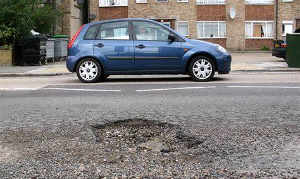Everything Wrong With My Decade-Old BMW F800GS

Last week, I picked up a 2013 BMW F800GS sight unseen off Facebook Marketplace. It was the cheapest one within five states of me, and I jumped at the opportunity to upgrade from my little single-cylinder Beemer to a full-scale adventure bike. But as it turns out, the bike was cheap for a reason — it needs some real work before it’s truly roadworthy.
This Foldable Electric Scooter Is a Motocompo for the 21st Century
I haven’t gotten the GS into a shop yet for a full, professional diagnosis of all its issues (a local shop, when I asked, simply said “I can’t help you with your problems” and hung up) but my own riding experience and diagnostics have shown there’s a lot going wrong. So, in rough priority order, here’s where my next few paychecks and weekends will be going.
Photo: Steve DaSilva / Jalopnik
Tires And Tubes
The photo above may be blurry, but your eyes don’t deceive you — that’s a date code for February of 2013 on my rear tire. The front is better, having been made in 2017, but still not exactly fresh. Both are an ADV design, meant for a mix of streets and dirt, but the front is oddly more aggressive than the rear.
Even discounting the age, neither tire is in great shape. The rear is squared off, and the front is worn down. They’ll be getting replaced with newer, slightly more street-oriented (though still dirt-capable) rubber. I don’t know the condition of the tubes inside, but they seem like an “as long as I’m in there” kind of upgrade.
If your bike has a detent in the middle of its steering range like this, then your head bearing might be shot tooGif: Steve DaSilva / Jalopnik
Steering Head Bearing
Ancient tires aren’t the only reason this GS is sketchy, however. These F800s are known for chewing through head bearings, and the gif above shows that mine is fully and totally shot. It’s deeply notched in the center, and you can really feel it while you ride. As a result, the bike doesn’t like to initiate turns — and, whether because of this or the tires, doesn’t feel confident mid-corner either.
This is a job that I don’t trust myself to do. Pressing bearings into the frame feels like something precise, something that should be handled by a professional with real, purpose-built tools. Hopefully, I won’t be needing this often enough for those tools to be worth buying.
In the comments when I first bought the bike, a lot of you mentioned suspension fixes – weak shock mounts, fresh fork oil, things of that nature. With how badly the bike rides right now, I have no way of even knowing what condition the fancy electronic suspension is in — I’m spending all my time just trying to keep the thing pointed the right way. After these fixes, I’m hoping to better be able to diagnose the suspension.
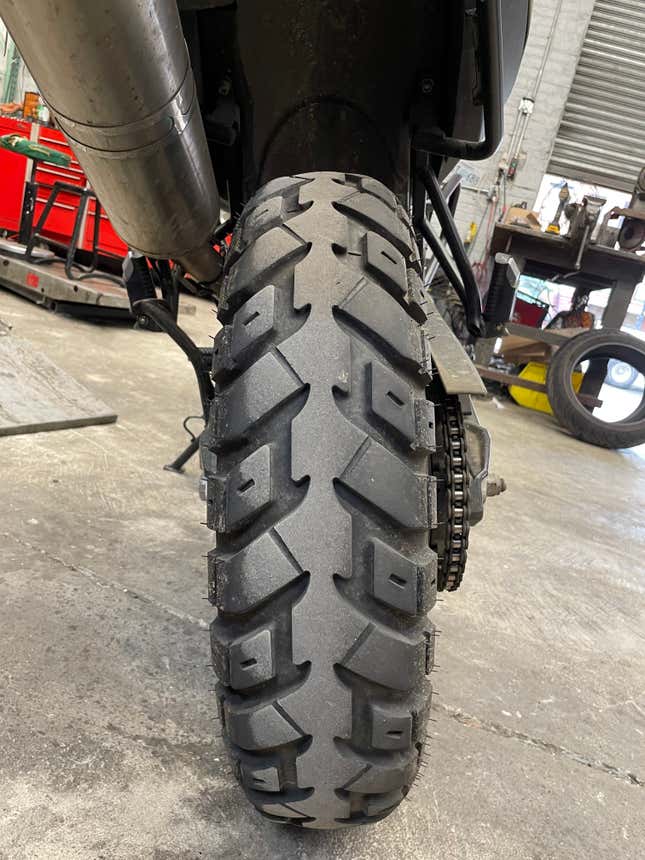
Photo: Steve DaSilva / Jalopnik
Wheel Bearings
I haven’t pulled the wheels off to check the condition of the bearings, but, given the state of the rest of the bike, I’m sure these are rough too. I’ll need to have the wheels off for the tires, tubes, and bearings anyway, so I may as well throw some bearings in while I’m there. This mentality is what we in the business call “scope creep,” and it’s how I ended up spending $3,000 on transmission work on my old FR-S.
This marks the end of what I’m calling “Priority 1″ repairs — issues that make the bike all but unrideable until they’re fixed. Once these are done, the wrenching isn’t finished, but at least I can take the GS out to go buy more parts.
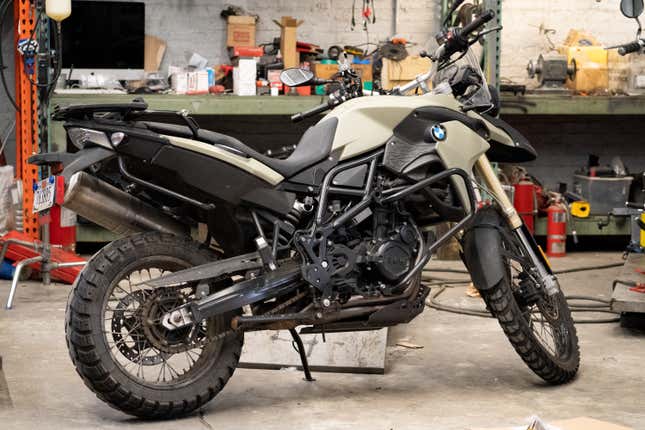
Photo: Steve DaSilva / Jalopnik
Oil Change
The base of the GS’s oil filter is actually visibly corroded, so it’s likely been on the bike for a long time. The oil level itself is good, but it’s definitely worth changing out. Time to find out exactly how many bolts hold that aftermarket skid plate on, I guess.
This is a very simple job, but it’s below some more complex things for a simple reason: I don’t trust this bike’s handling enough to ride out to my local RevZilla for oil and a filter. Once the handling is sorted, and the bike feels safe to ride again, I can start grabbing parts for the other, easier fixes.
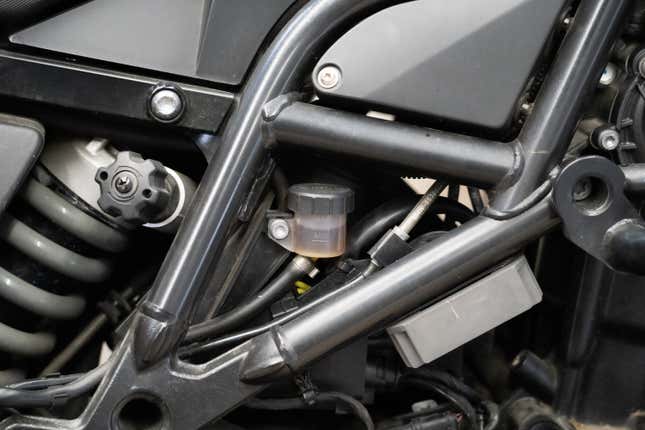
Photo: Steve DaSilva / Jalopnik
Brake Fluid
Speaking of easier fixes, this just needs a flush. The rear brake fluid is approximately the color of maple syrup, and it needs to go. I’ve somehow never actually flushed a brake system before, so this will be my first attempt. Place your bets now on how much paint I mess up by spilling fluid.
Oddly, the fluid for the front brake is in much better shape. I’ve got a theory as to why that is, but we’ll touch on that in another fix later on down the line.
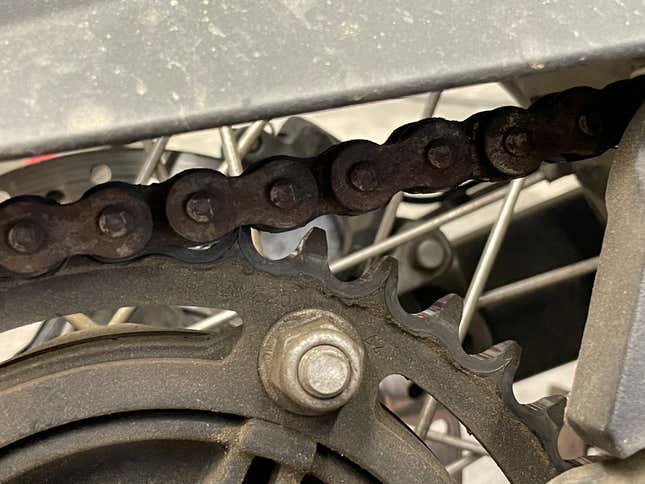
Photo: Steve DaSilva / Jalopnik
Chain and Sprockets
When I got the GS home to my garage, the chain tension was just barely out of spec — close enough that I could fix it with the bike’s existing adjustment range. But the actual condition of the chain itself, and the wear on the sprockets, makes me think the set isn’t long for this world. A new chain, with new sprockets to match, is in order.
This may mean buying a chain breaker/rivet tool, or it may mean begging or borrowing one from a local shop or fellow motorcyclist. Or, maybe I’ll wimp out and use one of those master links that just has a clip on it instead. I’m writing this for accountability — if I follow that route, you are allowed if not encouraged to dunk on me for it in the comments.
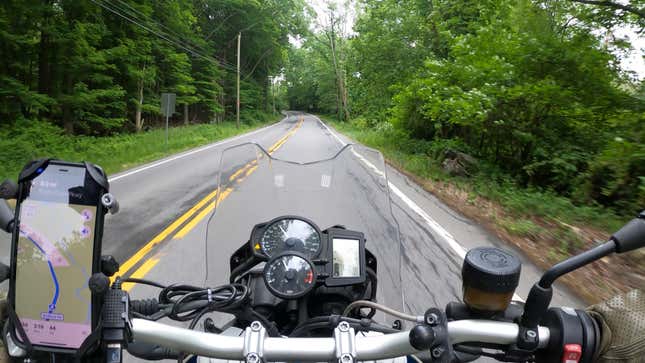
Photo: Steve DaSilva / Jalopnik
Valve Check/Adjustment
Given the overall state of this bike, I doubt it had its BMW-mandated 12,000-mile service. So, I’m including the parts from that service here to ensure the bike ends up in full working order. That means it needs the valve clearance checked, which makes the third job on the list that I’ll be farming out to the pros. The last thing I need is to mess that up by attempting to DIY it, and end up lunching a valve.
The valve check is this low on the list for a couple of reasons. First, while it is overdue, most people on the forums seem to have had no issues with valve clearance at this mileage — the checks all come back OK, within spec. That means the danger seems low, while the costs are high. If I can recoup some funds after my handling-fixing extravaganza before getting the engine figured out, I’d like to.
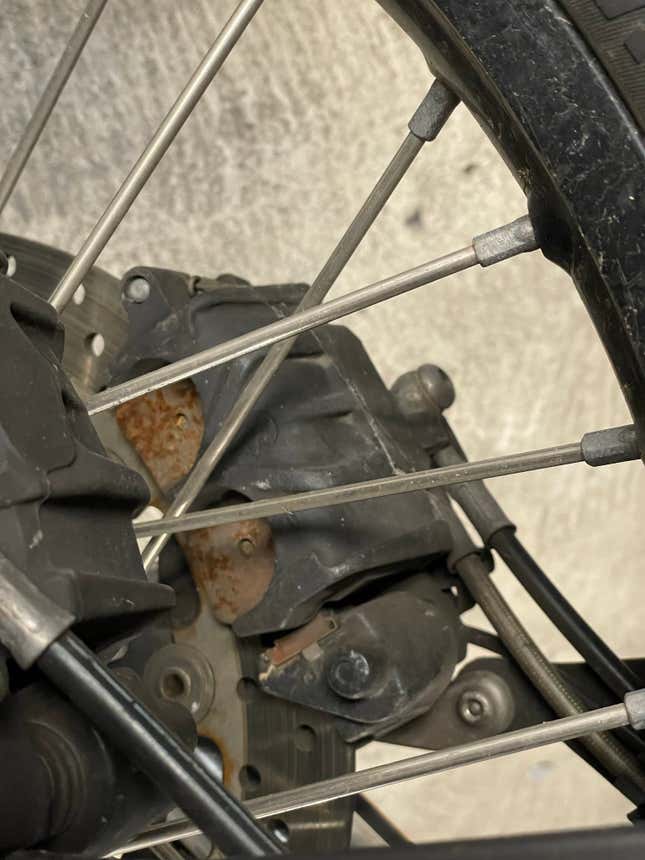
Photo: Steve DaSilva / Jalopnik
Brake Pads And Rotors
The pads and rotors on my F800 seem to have a good amount of stopping power left, but they’re clearly old — rusted under the calipers, ready for replacement. Even if they don’t necessarily need an update, as they seem to work well, brakes are a major safety item. I’d rather have new pads and rotors and not need them, than need them and not have them.
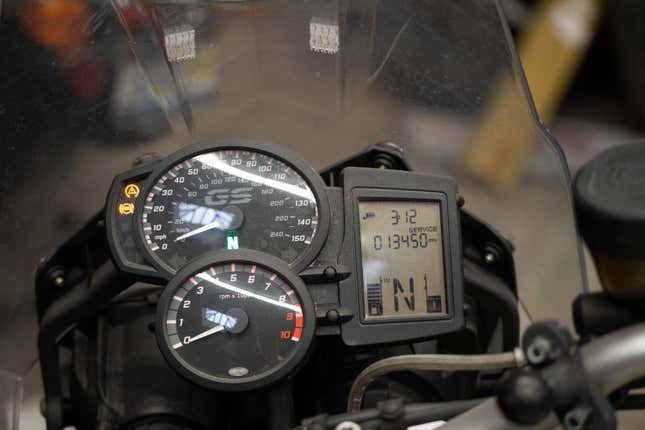
Photo: Steve DaSilva / Jalopnik
Air Filter
Another bit from the 12,000-mile service is the bike’s air filter. With the rear-mounted tank, the filter on this GS is actually up between my legs while riding — nice and easy to access with a couple of Torx bolts. For a few minutes of work and $35 in parts, there’s not much reason not to do it. But, at the same time, the F800 seems to run well, so I’m not really in a huge rush.
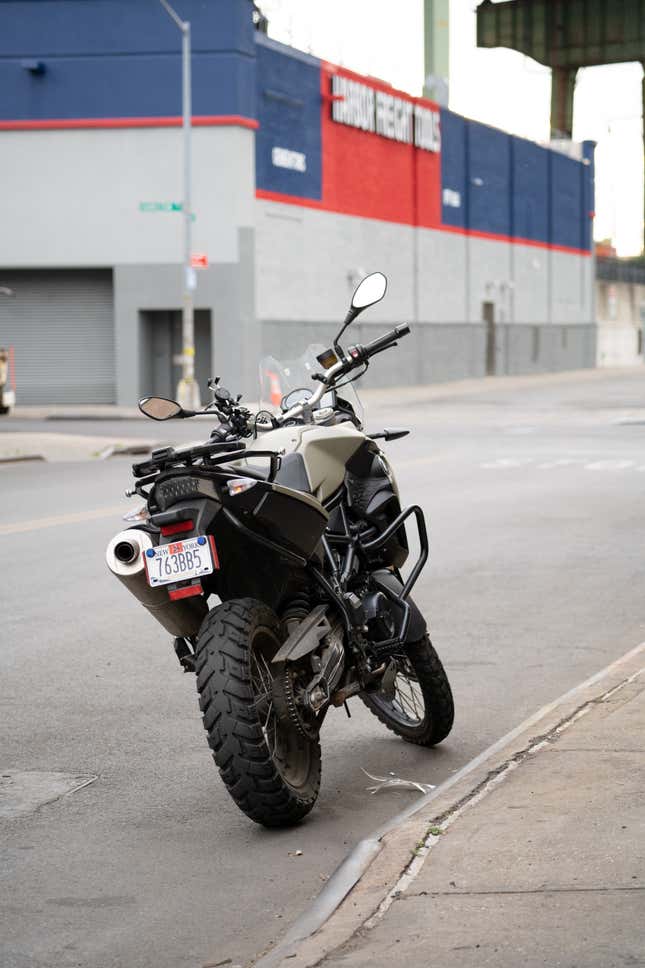
Photo: Steve DaSilva / Jalopnik
Battery
When I rode the bike home from my purchase, there was one odd, unnerving moment. I stalled the bike, not yet used to its clutch, and the starter seemed reluctant to get the engine turning again — taking three tries before it turned over. The battery may not need replacing, but I at least want to bring my multimeter down to the garage and check it out.
While I’m in there, it can’t hurt to check the charging system as well. F800GSes are known for burning through stators, and while mine is a 2013 model — the year BMW updated the design to keep stator temperatures lower — it’s not immune to the same faults. The sluggish start issue hasn’t recurred, so hopefully the electricals are fine.
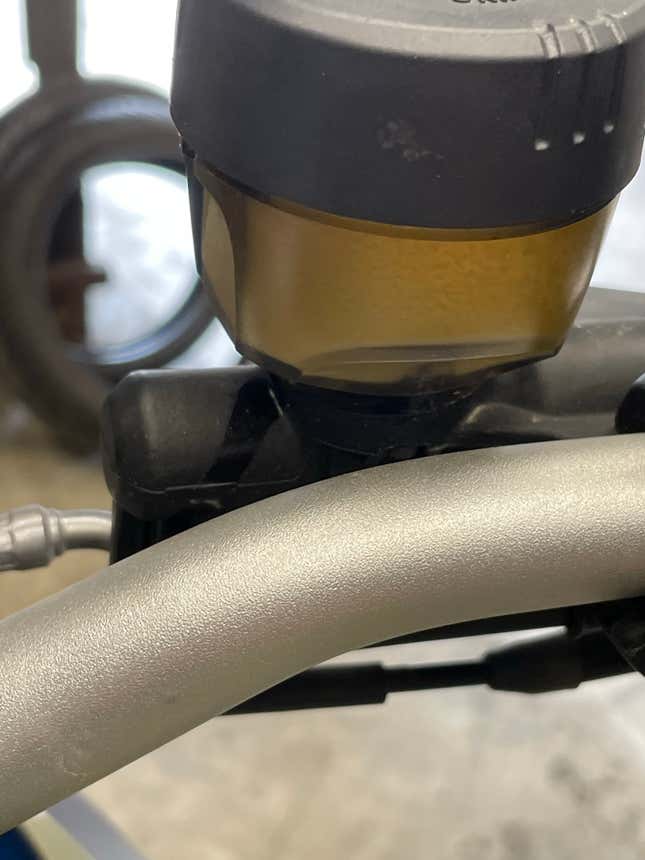
Photo: Steve DaSilva / Jalopnik
Front Brake Fluid Reservoir
Remember when I said the front brake fluid was in better shape than the rear, and that I had a theory as to why? Well, here’s my thinking: The front fluid reservoir has a very small leak, so it likely needed to be topped up every so often. Doing that enough times would keep the fluid fresher than the untouched rear system.
This repair is this far down the list because it’s a tricky one, parts-wise. BMW doesn’t seem to sell the reservoir individually, only as a kit with the cylinder included. I don’t think I need that, so I’m going to try and find an aftermarket unit that slots in. If that doesn’t work out, I’ll see about finding the full assembly used — or retrofitting the cylinder from the R1200GS, which seems to be a not-uncommon upgrade on the forums.
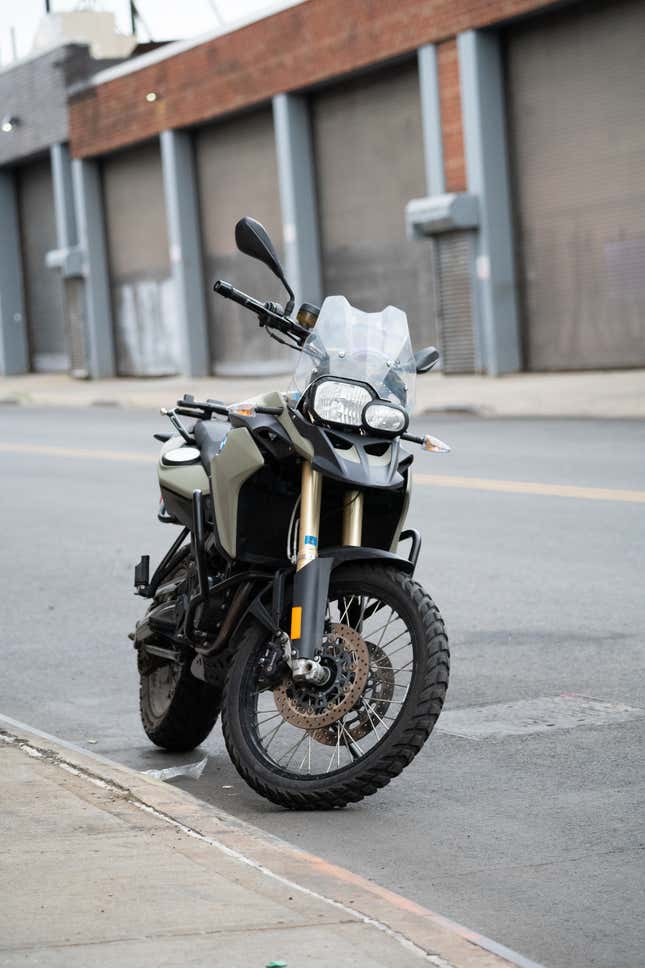
Photo: Steve DaSilva / Jalopnik
Windshield
This one is less a fix and more of a modification, but the stock windshield just isn’t tall enough to keep someone my height comfortable on the highway. The wind buffeting, particularly with the GoPro mounted on my chin to document my first ride with the new bike, was severe. This tiny stock windscreen needs to go.
There are a few ways I could go with this. A friend and fellow F800GS owner uses a Madstad adjustable setup, which he swears by, but those are expensive and (in my opinion, at least) not great-looking. Another option is to retrofit the mounting hardware for the taller factory windscreen that BMW offered on the GS Adventure — something that other forum users have done. The most tempting, however, may be a $34 windshield I found on AliExpress, if only because I want to know exactly how good or how bad a $34 AliExpress windshield is. It’s just plastic, right? How bad could it be?
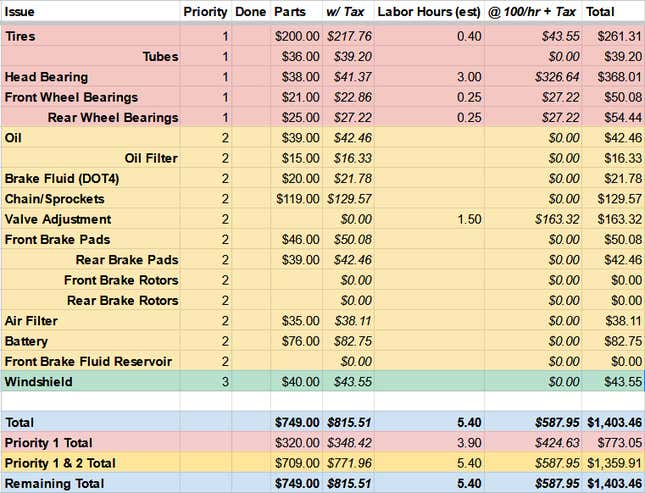
Screenshot: Steve DaSilva / Jalopnik / Google Sheets
Currently, that’s the list. I’m sure as I start working my way through the bike, I’ll find more issues, but that should be enough to get me out on the road again. If I’m really lucky, I can get everything done before too much of the riding season elapses. If not, well, at least I’ll have some fun wrenching on the new bike.




